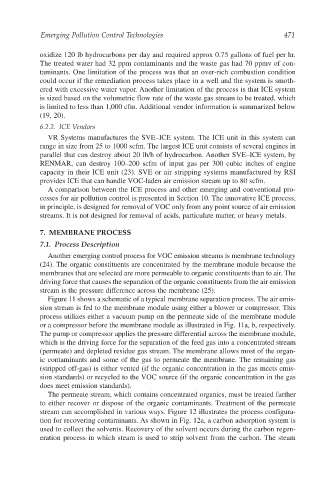Page 499 - Air Pollution Control Engineering
P. 499
12_ch_wang.qxd 05/05/2004 5:26 pm Page 471
Emerging Pollution Control Technologies 471
oxidize 120 lb hydrocarbons per day and required approx 0.75 gallons of fuel per hr.
The treated water had 32 ppm contaminants and the waste gas had 70 ppmv of con-
taminants. One limitation of the process was that an over-rich combustion condition
could occur if the remediation process takes place in a well and the system is smoth-
ered with excessive water vapor. Another limitation of the process is that ICE system
is sized based on the volumetric flow rate of the waste gas stream to be treated, which
is limited to less than 1,000 cfm. Additional vendor information is summarized below
(19, 20).
6.2.2. ICE Vendors
VR Systems manufactures the SVE–ICE system. The ICE unit in this system can
range in size from 25 to 1000 scfm. The largest ICE unit consists of several engines in
parallel that can destroy about 20 lb/h of hydrocarbon. Another SVE–ICE system, by
RENMAR, can destroy 100–200 scfm of input gas per 300 cubic inches of engine
capacity in their ICE unit (23). SVE or air stripping systems manufactured by RSI
provides ICE that can handle VOC-laden air emission stream up to 80 scfm.
A comparison between the ICE process and other emerging and conventional pro-
cesses for air pollution control is presented in Section 10. The innovative ICE process,
in principle, is designed for removal of VOC only from any point source of air emission
streams. It is not designed for removal of acids, particulate matter, or heavy metals.
7. MEMBRANE PROCESS
7.1. Process Description
Another emerging control process for VOC emission streams is membrane technology
(24). The organic constituents are concentrated by the membrane module because the
membranes that are selected are more permeable to organic constituents than to air. The
driving force that causes the separation of the organic constituents from the air emission
stream is the pressure difference across the membrane (25).
Figure 11 shows a schematic of a typical membrane separation process. The air emis-
sion stream is fed to the membrane module using either a blower or compressor. This
process utilizes either a vacuum pump on the permeate side of the membrane module
or a compressor before the membrane module as illustrated in Fig. 11a, b, respectively.
The pump or compressor applies the pressure differential across the membrane module,
which is the driving force for the separation of the feed gas into a concentrated stream
(permeate) and depleted residue gas stream. The membrane allows most of the organ-
ic contaminants and some of the gas to permeate the membrane. The remaining gas
(stripped off-gas) is either vented (if the organic concentration in the gas meets emis-
sion standards) or recycled to the VOC source (if the organic concentration in the gas
does meet emission standards).
The permeate stream, which contains concentrated organics, must be treated further
to either recover or dispose of the organic contaminants. Treatment of the permeate
stream can accomplished in various ways. Figure 12 illustrates the process configura-
tion for recovering contaminants. As shown in Fig. 12a, a carbon adsorption system is
used to collect the solvents. Recovery of the solvent occurs during the carbon regen-
eration process in which steam is used to strip solvent from the carbon. The steam

